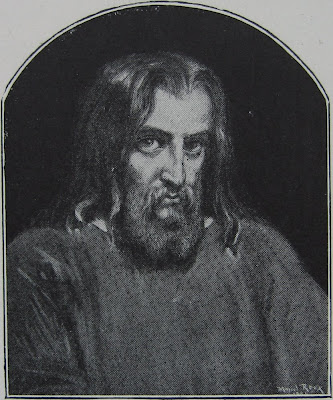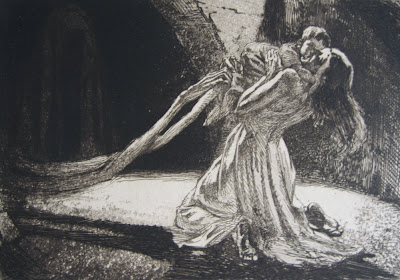I have recently acquired a very curious double set of prints (one set printed in black, the other in sanguine) issued alongside Le Bouquet de la Mariée (The Bride’s Bouquet), a collection of poems by Gabriel-Joseph Gros, the biographer of Utrillo. This was published by Marcel Sautier, Paris, in 1945, printed by Imprimerie Chaix in February of that year, six months after the Liberation of Paris. There were a total of 630 copies. I already possessed a copy of the book, one of the four hundred copies printed on pur fil d’Angoumois. These copies contain no illustrations at all, but the justification page makes intriguing mention of illustrations in the first 230 copies.

Le Bouquet de la Mariée, copy 344/630
As I now know, these 230 copies, printed on pure rag Lana wove paper, have an etching by André Derain on the cover and contain after the title page a page printed with a Denyse de Bravura drypoint, and a list of 30 artists who have ‘amicalement offert les bouquets pour la mariée’. And sure enough, in a separate wrapper is a sheaf of 30 assorted drypoints, etchings, engravings, and lithographs by various artists working in France at this period. The lithographs were printed by Mourlot or Desjobert, the etchings, drypoints, and engravings by Paul Haasen, all on Lana. The first 30 copies of the book had an extra set of the same prints printed in sanguine. As my copy is no. 5, I also have one of these.

Le Bouquet de la Mariée, copy 5/630, with an etching by André Derain
All of the images are of flowers, weddings, or a combination of the two. Apart from this reflection of the theme of the book’s title, the prints bear very little relation to the book. It seems doubtful if any of the artists knew any more about its contents than the title. The only organic connection between prints and book is the size of the sheets, which is 225 x 140 mm (eight and three-quarters by five and a half inches).

Le Bouquet de la Mariée, justification page signed by Gabriel-Joseph Gros
The artists commissioned to create original prints for this project range from the world-famous, such as André Derain, Othon Friesz, and Louis Valtat, to the completely obscure, such as Henriette le Grix and Hélène Marre. Inevitably the prints are of varying quality. There are no great works of art among them, but some charming images from artists such as André Marchand, Marie Laurencin, and André Planson. My personal favourites are those by Valtat, Laurencin, and Crotti. So without more ado, please enjoy some selected flowers from this bridal bouquet that has survived unperished since the closing months of the Second World War.

Albert André, lithograph
Albert André (1869-1954) was born in Lyon. He began life as a designer in the textile industry, but soon moved to Paris to study at the Académie Julian under Bouguereau. There, André made a close lifelong friend in the future Fauve, Louis Valtat. At the 1894 Salon des Indépendants André’s work impressed Pierre-Auguste Renoir, who introduced him to the influential Galerie Durand-Ruel, who became his dealer. In 1917 André became curator of the museum in Bagnols-sur-Cèze, now the Musée Albert André, which thanks to his contacts houses a significant collection of Impressionist and Post-Impressionist work. He remained a working artist, and was a prominent member of the Salon d’Automne, with which he exhibited from 1904-1944.

Pierre-Eugène Clairin, etching
Pierre-Eugène Clairin (1897-1980) was born in Cambrai, the child of a French father and an American mother. Educated in England, Clairin went to Paris to study under Fernand Cormon at the École des Beaux-Arts. In WWI he became a pilot, and was seriously injured. After the war, he worked with Paul Sérusier at the Académie Ranson, as a result of which he became friendly with Édouard Vuillard.

Jean Crotti, drypoint
Jean Crotti was born in Bulle in the Canton of Fribourg, Switzerland; he was naturalised French in 1927. Crotti began his studies in Munich before entering the Académie Julian in Paris in 1901. At first influenced by Impressionism, Fauvism, and Art Nouveau, by 1910 Crotti was in the sway of Orphism and Italian Futurism. In fact Jean Crotti's career was to encapsulate a mini-history of twentieth-century art movements, for he was to play a significant role in Dadaism before turning to geometrical abstraction. Two important figures in Crotti's artistic development were Francis Picabia and Marcel Duchamp, whom he met in New York during WWI. Duchamp was also important in Crotti's personal life, as on returning from New York with news of Marcel, Crotti met and married his sister Suzanne Duchamp.

André Derain, drypoint
André Derain (1880-1954) was born in Chatou, outside Paris. Derain was the son of a baker, and destined to become an engineer, but at the age of fifteen he started taking art lessons. By 1898 Derain was studying under Eugène Carrière, and it was at Carrière’s studio that he first met Henri Matisse, who was to be his lifelong friend. Two years later, on a train, he met and befriended Maurice de Vlaminck. As one of the founders of Fauvism, alongside Matisse, de Vlaminck, Braque. Marquet and Friesz, André Derain has an important place in the history of modern art.

Othon Friesz, drypoint
Henri-Achille-Émile-Othon Friesz (1879-1949) was born in Le Havre, Normandy in 1879. In 1934 Raoul Dufy described Othon Friesz as “the most gifted painter of our generation”. Friesz and Dufy first met at the Lycée in Le Havre, and the two became lifelong friends. They studied together at the Beaux-Arts in Le Havre, and lived and worked together in Paris, where they studied at the Beaux-Arts alongside Matisse, Marquet, Rouault, Manguin, and Camoin. From 1905-1908 Othon Friesz rented a studio alongside Matisse. Already by December 1905 he was exhibiting alongside Derain, Matisse, and Vlaminck. Painting trips with Braque to Antwerp in 1906 and to La Ciotat in 1907 added to this mix of influences, and Othon Friesz became one of the leaders of the new Fauve movement. Under the influence of Cézanne and of Picasso, Othon Friesz moved away from the bright colours of Fauvism to a more austere and classical style, based on the simplification of line. In the 1920s he taught with Fernand Léger at the Académie Moderne. As a printmaker, Othon Friesz favoured lithography for its speed, flexibility and painterly qualities, although he also made etchings, wood engravings, and drypoints such as this one, with its pronounced drypoint burr.

Édouard Goerg, etching
Édouard Goerg (1893-1969) was introduced to etching by Jean-Émile Laboureur, and became one of the foremost printmakers in twentieth-century France - President of the Société des Peintres-Gravures Français, and professor of printmaking at the Beaux-Arts, Paris. Although one of the most French artists of the twentieth century, Édouard Goerg was actually born in Sydney, Australia. Goerg studied at the Académie Ranson with Maurice Denis and Paul Sérusier.

Marie Laurencin, etching
Marie Laurencin (1883-1956) was born in Paris. At the age of eighteen she began work painting porcelain in Sèvres, before returning to Paris to study art in the Académie Humbert, with the idea of improving her skills, rather than becoming an artist. But she met Georges Braque, who introduced her to Pablo Picasso. Soon she was frequenting Picasso's studio at the Bateau-Lavoir, and embarking on a passionate affair with the poet and art critic Guillaume Apollinaire. She was at the very heart of the Paris avant-garde. In 1914 she married Baron Otto von Waëtjen, and left France to live in Spain. On their divorce in 1920, Laurencin moved back to Paris, where she associated once again with Picasso and his circle. Her work can be regarded as a highly feminine take on Cubism, soft and curved where classical Cubism was hard and fractured.

André Marchand, lithograph
The painter and lithographer André Marchand (1907-1998) was born in Aix-en-Provence. Marchand first exhibited at the Salon d'Automne in 1932. In the 1930s he exhibited with the group Forces Nouvelles, with Tal-Coat and Gruber. The formative influences on the art of André Marchand were Cézanne, Picasso, and Matisse.

André Planson, lithograph
André Planson (1898-1981) was one of the leading figures in the group La Réalité Poètique (Poetic Reality), alongside Roger Limouse, Maurice Brianchon, Roland Oudot, Raymond Leguelt, Kostia Tetechkovitch,, and Christian Caillard. He taught at the Académie Julian in Paris. Planson was born at La Ferté-sous-Jouarre (Seine-et-Marne), into a family of wine-growers. His artistic ambitions were nurtured by the landscape painter Paul Meslé, and for a short period he studied under Maurice Denis at the Académie Ranson.

Louis Valtat, etching
The Fauve painter Louis Valtat (1869-1952) was born in Dieppe, into a wealthy family, with a father - himself an amateur painter - who supported him in his art studies At the École des Beaux-Arts, Paris, he studied in the ateliers of Boulanger, Lefebvre, and Harpignies, and possibly briefly in that of Gustave Moreau. At the Académie Julian, he made friends with fellow-students such as Bonnard, Vuillard, and his close friend Albert André. In 1895 Valtat, Toulouse-Lautrec, and André collaborated on the stage designs for an Indian drama, Chariots de terres cuites, staged at the théatre de l'Oeuvre. At his point Valtat was very close to the Nabis, but soon his experiments with violent colour were to mark him out as one of the principal Fauves.
Unillustrated here are etchings by Maurice Asselin, Eugène Corneau, André Fraye, Edmond Heuzé, Hélène Marre, Maurice Savin, Suzanne Tourte, and Louis Valdo-Barbey; drypoints by Camille Berg, Denyse de Bravura, Michel Ciry, Hermine David, Robert Lotiron, Jean Serrière, Kostia Terechkovitch, and Louis Touchagues; lithographs by René Demeurisse, Henriette Le Grix; and copper engravings by Pierre Dubreuil and Raymond Haasen.































